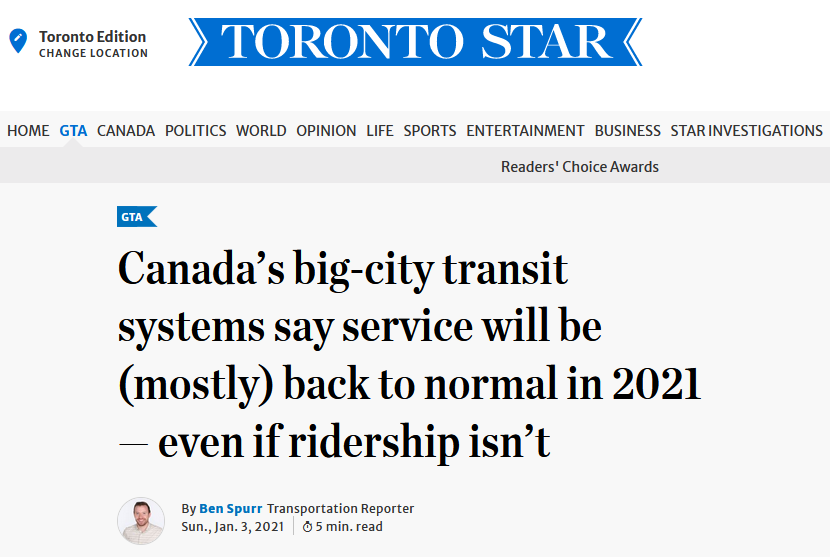Opinion by Cameron MacLeod
Executive Director, CodeRedTO
In response to losing up to 90% of their ridership and revenue due to Covid-19 last spring, transit systems across North America suspended up to 90% of their service. However, they retained easily 90% of their costs. Resulting budget shortfalls led to dire warnings about the end of public transit as we know it. As 2020 ends, many agencies have restored significant service levels, and governments have provided cash infusions to mostly replace missing fare revenue. These are positive signs, but transit remains at risk.
While the TTC has reinstated most employees, the distribution of their service is dramatically different. That’s a good thing, as they’ve learned more precisely where essential worker and non-car-owning riders travel. In Toronto that means strong ridership in the northern halves of Scarborough and Etobicoke. The largest drops in ridership can be found on routes between wealthier areas in central Toronto and the financial district as those daily commuters now work from home. The TTC could run the subway at half-capacity and it still might not feel as crowded as in previous years, even as they increased bus service elsewhere. Modifying service is normal but does not resolve increasing pressures on operations funding, and expansion choices.
We know transit funding and service before COVID was not sufficient. The TTC regularly cut service in one area to address greater needs elsewhere, rather than adding more buses driven by operators they couldn’t afford to pay.
The funding was also not sustainable, as massive capital expenditures arrived each election without accompanying operating dollars. For example, the Vaughan subway extension is projected to cost the TTC $30 million more per year to operate than it will bring in revenue.
Finally, the funding is unpredictable by choice. Toronto City Council provides the TTC with about $790 million of its $2.1 billion operating budget, debated and contested each year, and often accompanied by fare hikes greater than inflation. Queen’s Park used to make a substantial contribution to the TTC’s operating funds, but now focuses solely on expansion. The lack of predictable funding from dedicated revenue sources complicates any long-term planning and service consistency to keep people moving efficiently.
Network expansion pressures also change, as we see a greater need for reliable rapid transit for essential workers which cannot be addressed with costly tunnels alone. We know a relief line (whatever its name or technology) from the east into the core will be needed in 10-12 years when it opens, but we will also need the Jane LRT, the Eglinton Crosstown East (to UTSC and Malvern) and West (to Pearson Airport) extensions, and Waterfront East LRT to the rapidly-developing Port Lands.
When we are back to “normal,” people may be afraid to ride transit if insufficient service makes it overcrowded, and there is a possibility many will choose private car travel. If only 10% of the TTC’s ridership makes this choice, that is roughly equivalent to an entire additional Gardiner Expressway of cars. Losing these rush-hour riders would also reduce the TTC’s efficiency, as the subway’s operating cost doesn’t change much whether empty or full, leading to significant budget impacts.
The competition for funding will likely intensify, as vital health care and vaccination programs will understandably tempt governments to delay or cancel other projects, as seen in previous economic shocks. The Eglinton subway was cancelled in 1995 while under construction, and funding for the Crosstown and Finch lines were delayed in 2009.
We know that public transit is vital to a healthy economy and community, but as federal legislators spend more time on airplanes than buses, federal support for transit tends to be late, conditional, insufficient, and one-time-only. As former New York City Transportation Commissioner Janette Sadik-Khan tweeted in December 2020, “Public transportation carries 10x more people than airlines yet Congress thinks it needs $1 billion less aid. Not everybody rides transit but everyone is dependent on those who do.”
In the post-vaccine world, if we do not invest in transit, ridership will remain low and private car congestion will skyrocket—and transit agencies will put more pressure on city budgets. It is essential that we choose a sustainable future state, and not fall into the old habit of just shrugging and accepting an inadequate transit system.
